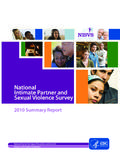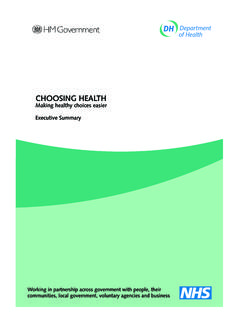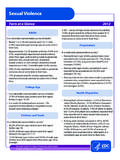Transcription of Battle-scars: Long-term effects of prior domestic …
1 Battle- scars : Long-term effects of prior domestic violenceBattle- scars : Long-term effects of prior domestic violenceDr Ilsa EvansCentre for Women s Studies and Gender Research Monash UniversityFebruary 2007 Battle- scars : Long-term effects of prior domestic violenceAcknowledgementsThis report was made possible with an award through the Monash University Postgraduate Research School, and support through the Centre for Women s Studies and Gender Research, Monash University. In particular I would like to thank Professor Rosemary Calder for giving so readily of her time and guidance during the formulation of this report and Dr Maryanne Dever for her ongoing assistance. I would also like to thank Dr Jo Lindsay for her invaluable help with the research and Ashton De Silva, of the Department of Econometrics and Business Statistics (Monash University), for his help with the statistical analysis. Lastly, but most importantly, I would like to offer my sincere thanks to all of the study participants whose willingness to share their stories breathed life into this 0-9756822-2-9 Battle- scars : Long-term effects of prior domestic violenceContentsPreamble 4 Executive summary 5 Implications and recommendations 71 Methodology Aim About the study 101.
2 Research tools Research participants Terminology 102 Battle- scars : The case studies 11 Health: The impact of health-related repercussions of domestic violence and the medical response 1 .1 Key findings 1 .2 Overview of abuse suffered during the abusive relationship 1 . Ongoing psychological damage 1 .4 Long-term implications depression 14 .5 Post-traumatic Stress Disorder (PTSD) 14 .6 Other psychological disorders 15 .7 Long-term physical damage 15 .8 Long-term sexual damage 16 .9 Responses by the medical community 17 .10 Summary and recommendations 184 Justice: The Long-term impact of legal issues on the post-separation experience Key findings Property settlement. 194. Issues of child residence/contact The legal system: perceptions and reality Summary and recommendations 2 5 Financial wellbeing: The repercussions of prior domestic violence on Long-term income, employment and education Key findings Economic repercussions of an abusive relationship 245.
3 (Un)employment and/or welfare dependency Shifts in education and employment Housing insecurity Summary and recommendations 296 Child support: receipt of child support and experiences with the Child Support Agency (CSA) Key findings The Child Support Agency (CSA) 16. Ongoing contact via the CSA and child support Strategies used by perpetrators to minimise payments Perceptions of the bureaucracy Positive aspects of the CSA Summary and recommendations 47 Parenting: The repercussions of domestic violence on the parenting of both survivors and perpetrators Key findings Long-term damage to children 57. Inter-generational transmission Child contact and visitation Child contact used as control Without access/contact Conflicts within parenting Seeking assistance Summary and recommendations 408 Community Services: the response of family and community services to the post-relationship journey Key findings Actively seeking community/social support 418.
4 Allowable time for support Supporting others turning abuse into expertise 4 Support of religious organisations and/or faith alone Summary and recommendations 469 Incorporation rather than recovery: an alternative way of viewing the post-relationship journey Key findings Concepts of recovery 479. Realities of the post-relationship journey for DV survivors Concepts of incorporation Survivor an evolving but lifelong identity Summary and recommendations 51 References 5 Appendices 58 Battle- scars : Long-term effects of prior domestic violence4 PreambleDomestic violence (DV)1 describes a range of abuses perpetrated within a domestic setting, whether physical, financial, sexual, spiritual, social, or emotional, where one family member seeks to dominate another. DV does not describe a single incident but rather is a pattern of behaviour that often escalates over time, gradually undermining the victim s confidence and ability to leave the perpetrator (DVIRC, 2005).
5 DV also increases the risk of depression, substance abuse and suicide in victims, especially for women (Stark & Flitcraft, 1996). Women are the victims in about 90% of all identified incidence of DV (NSW Lawlink, 2005). Given that men are the majority of perpetrators and women (and children) form the majority of the victims, the aetiology of DV can be seen as directly linked to the relationship between gender and power (Gilmore, 1989). Thus, for good reason, violence against women in its entirety is increasingly being acknowledged as a gender-based violation of human rights, with Amnesty International (2004) calling it the greatest human rights scandal of our repercussions of DV are not limited to the timeframe of an abusive relationship itself. Instead, as the Australian study Against the Odds (1998: 90) found, it is important to view DV as a continuum that has a lingering impact long beyond the point of separation and/or divorce.
6 This continuum can be complex and far-reaching. It has the potential to impinge on ongoing issues such as finances, employment, overall health, effective parenting, inter-familial relationships, and the need for ongoing support services. Yet there has been little research directed exclusively at this area and how these Long-term effects can influence the ability of survivors to rebuild and rejoin society to their full potential. Instead most contemporary literature dealing with DV tends to treat the post-relationship period as a finite period marked by resolution and restoration, rather than as an ongoing experience marked by continuing repercussions. This situation appears to have arisen principally from the logical focus of DV research on those periods where immediate danger is the central or most explicit issue. This has resulted in a concentration on the abusive relationship up to, and including, the crisis point of separation (for example, Ferrante, 1996; Hegarty & Roberts, 1998; Stubbs, 1999).
7 Given this focus, there is a lack of acknowledgement of longer-term effects in a range of policy and service responses to DV and its effects on families, women and children, and this potentially diminishes the benefits and outcomes of those policies and services: Many agencies that work with battered women provide services up to the point where the woman has left her batterer and secured independent housing and income. Whilst these are critically important steps for battered women, they are not the end, as many would see them. Instead they mark the beginning of a profound struggle for battered women to come to terms with their Also known as Family violence experience, build a positive sense of identity, and achieve a sense of wholeness. (McHugh, 2001: 1)Battle- scars : Long-term effects of prior domestic violence specifically focuses on the impact that an experience of DV can have on the lives of survivors after separation from the abusive relationship and onwards.
8 Currently, much of the community service response to this period is based on expectations of recovery of the women from the experience and her re-establishment outside of that relationship, and this does not commonly include an understanding of or focus on the potential continuing ramifications of prior abuse on the Long-term post-relationship journey. This report takes up the view that DV does have Long-term impacts that should be taken into account in recovery service provision and support, and has comprehensively examined the ongoing costs both to the community and to individuals of these report is based on a research project (Evans, 2005) conducted in 200 -2005 with 1 4 female DV survivors. Both the project and this report emphasise the survivor-perspective and identify the voices of research participants as legitimate and fundamental sources of knowledge (Campbell and Wasco, 2000). Methodological choices for the project were made on the basis that DV is a gendered violation of human rights that works to suppress its victims, and that the experience of women post-separation need to be heard.
9 DV survivors often find that their experiences and difficulties are diminished or reduced by the attitudes and processes of the services with which they interact. For these reasons a qualitative approach was selected as the primary method with which to interpret the experiences of the women and address the findings of this report address an empirical and conceptual gap in available knowledge. An acknowledgement of the Long-term impact of prior DV is important to our overall understandings of this multifaceted phenomenon (Smith, 200 : 544), and the ways in which such a history continues to impact on a survivor s experiences needs to be fully appreciated to enable an effective response. The Long-term impacts of DV have significance for a range of government departments and community groups, such as family services, justice, health or community support organizations. This report proposes that government policies and services will be most effective in responding to and redressing the impacts of DV when services are coordinated across all relevant departments through a policy framework that aims to recognise the full spectrum of needs of survivors and to provide early intervention and access to support for the Long-term post-DV and separation impacts for : Long-term effects of prior domestic violenceExecutive summaryDomestic violence (DV) is one of the most serious social issues facing our society and is increasingly recognised as a human rights issue, defined and protected under international law, and as a criminal issue (DVIRC, 2005).
10 In 2002-200 , the total number of current Australian victims was estimated at 408,100, with an annual cost to the economy of approximately billion dollars (Access Economics, 2004: vii). The majority of victims are women, and the majority of victims eventually leave their abusive relationship (Seddon 1989). Policies and services within Australia have been long established to support women as victims and to assist women to leave abusive relationships. However, leaving an abusive relationship does not end the impact of DV instead, a personal experience of DV carries into future experience a range of Long-term repercussions that have a continuing impact within the lives of survivors. This report examines these repercussions for women survivors in terms of six broad service areas: health, justice, income, child support, parenting, and social support services. It does this primarily through the analysis of a comprehensive study of 1 4 women survivors of violent relationships.








